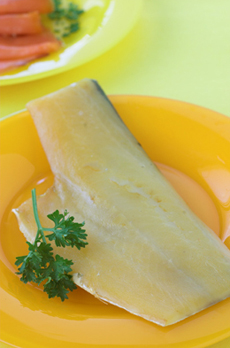|
|
Pronounced gooey-duck, this is an enormous Pacific soft-shell clams. It is mostly found in the northwest Pacific, and can weigh up to 12 pounds—though they average 3 pounds. It is the largest intertidal, burrowing bivalve in the world, with a shell of 6 inches and a neck that can extend up to a foot and a half. Difficult to obtain, geoducks are rarely marketed. When found, the neck can be cut or ground for chowders, and the body meat can be prepared like abalone, which it resembles. Clam Trivia: Based on fossil records, geoducks are among the oldest living animals in the world. |
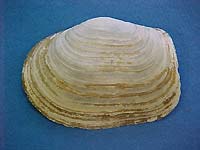 |
|
| Photo courtesy Edmonds Discovery Programs. |
GROUPER
|
This, the largest of the sea bass family, is usually found in the tropical and subtropical waters of the Atlantic and Gulf of Mexico. There are more than 100 species, from the quite small coney (9 inches) to the 9 foot, 600 pound spotted jewfish. All are important food fish. Typically, it grows to 5 to 15 pounds and can be found whole as well as in fillets and steaks. Grouper has a lean and firm meat that is suitable for most dry heat methods of cooking. It should be skinned before cooking, as the skin has a strong flavor. |
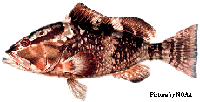 |
|
| Red grouper. Photo courtesy The National Oceanic and Atmospheric Administration (NOAA). |
HADDOCK
|
One of the members of the cod family, the haddock is the most important food fish in the Atlantic waters. It is small, rarely growing to larger than 30 pounds, and more typically between two and six pounds. Like all cod, its meat is low-fat, with firm texture and mild flavor. Most haddock is frozen in fillets and steaks. It can be prepared in any manner. Smoked haddock is called finnan haddie. |
 |
|
| Photo courtesy of ChartingNature.com. |
HAKE
|
Another member of the cod family, hake is found in the Atlantic and northern Pacific Oceans. Like all cod, its meat is low in fat, white and delicately flavored. A predator, it is one of the smaller cod, only growing to 8 pounds. Fresh hake is sold whole, in fillets or steaks, as well as sold frozen, smoked and salted. |
 |
|
| Photo courtesy of ChartingNature.com. |
HALIBUT
|
One of the larger flatfish, and in fact a species of flounder, halibut is abundant in the northern Pacific and Atlantic. Pacific halibut are the largest flatfish as well as one of the largest fish species in the sea. Their Latin name is Hippoglossus, or “hippos of the sea” (80% come from Alaska). While 1000-pound halibuts are caught, most are only 20 to 100 pounds. Like all flounders, halibut is low-fat, white, firm and mild with a big flake. These bottom feeders taste so good because their diet consists of smaller fish, crustaceans, and invertebrates. Occasionally, halibut cheeks, a delicacy served in fine restaurants, are available in specialty markets. Halibut are They are a variegated chestnut brown on the top to camouflage into the sea bed with a creamy underbelly to resemble the light above. They can grow up to 500 pounds with current minimum landing size of 32 inches, about 8 years of age. |
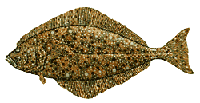 |
|
Photo of whole halibut courtesy of TridentSeafoods,com. Photo of fillet courtesy FoodShed Exchange.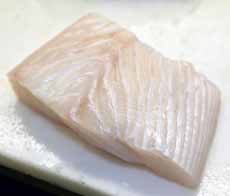 |
FUN FACT: Halibuts are born with an eye on each side of their flat heads, swimming with their bellies towards the bottom. At about 6 months of age and about 1 inch long, the left eye migrates over the head to the right side. Soon they begin to swim flat like adults and migrate down the water column to their home on the sea bottom.
HERRING
|
A huge, and hugely popular, family of salt- and freshwater fish with over a hundred varieties. Most herring swim in enormous schools and can be found in the cold waters of the North Atlantic and Pacific oceans, the Mississippi River, the Finger Lakes of New York and other places. Herring are small, maturing between 1/4 and 1 pound, and silvery. Young herring are frequently packaged as sardines, though the only true sardine comes from the Mediterranean. In the U.S., two of the most popular herring are the anadromous shad and the alewife, both of which live in saltwater, then migrate to freshwater to spawn. The shad is also a rule breaker in that it grow to 3 to 5 pounds, and in the spring, its eggs—shad roe, a delicacy—cause a stir. As a high-fat fish, the fresh meat has a soft, fine-grain texture best suited for dry heat cooking. Most often, it’s encountered in one of its many cured forms: |
 |
|
| Atlantic herring. Photo courtesy of ChartingNature.com. | ||
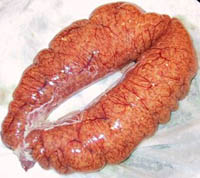 |
||
| Shad roe. |
- Pickled herring, a popular form in Scandinavia and Russia, is marinated in vinegar and spices, then canned in either a wine or sour cream sauce.
- A rollmop is a cured herring fillet, rolled up and preserved in vinegar, flavored by onions and spices.
- A kipper (or kippered herring) is a split and smoked herring, and a Bloater is a whole smoked herring. Both of these smoked herring are important in British cuisine.
- “Raw” herring (really enzyme-cured like ceviche) with raw shredded onions is a typical Dutch delicacy.
- Silds are immature Herrings that are canned as sardines in Norway.
- Very young Herring called Whitebait are eaten or cooked whole. Herring can also be prepared as herring soup.
- In Germany, herring is pickled to make matjes, or soused herring, curing them in a spiced sugar-vinegar brine.
Continue To Page 7: Seafood Terms Beginning With J, K & L
Go To The Alphabet Index Above
Lifestyle Direct, Inc. All rights reserved. Images are the copyright of their respective owners.
![]()
© Copyright 2005-2025 Lifestyle Direct, Inc. All rights reserved. All images are copyrighted to their respective owners.




